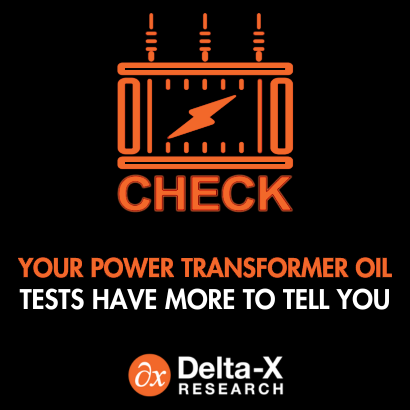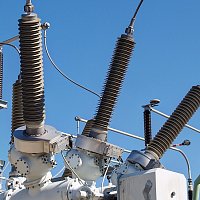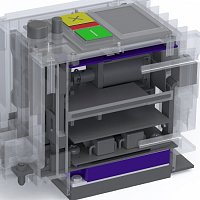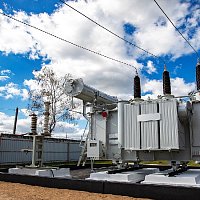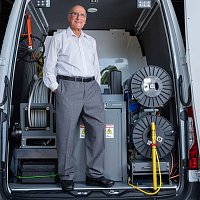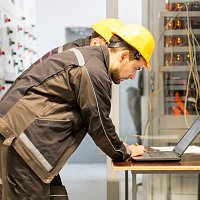
Image for illustrative purposes
INTEGRATION OF THE EV INTO THE GRID
When we talk about integrating electric vehicles (EVs) into the home and grid, people typically think about the process of connecting EV charging systems with the electrical infrastructure of the home, and by extension, to the power grid. This integration can include installing charging equipment in the home, connecting the charging system to the grid, and using smart technology to manage the charging process.
Implications of the EV
Our first consideration is, “what does an EV means to the home and the grid?” The average U.S. home used 29 kilowatt-hours (kWh) daily in 2021 according to the Energy Information Administration (EIA).1 The average U.S. daily commute was reported to be 41 miles per day by Zippia in February of 2023.2 EVs typically get between 2 to 4 miles of range per kWh consumed. This means that for the average U.S. daily commute, we would expect to see a charge requirement of between 10 to 21 kWh per day. Where does charging occur? The U.S. Department of Energy says over 80% of all EV charging occurs at the residence.3 What this means is that we are going to see residential power consumption grow by 28% - 58%. Certainly, public charging could potentially help relieve some of this by making it more accessible, but it will never be as convenient as residential charging. This will result in a significant burden on the residential power distribution system.
When EVs are integrated into the home and grid, several benefits can be realized. For example, it can make charging more efficient and cost-effective, by optimizing charging times and avoiding peak demand periods. It can also help reduce the strain on the grid, by enabling EV owners to charge their vehicles during off-peak hours.
There are additional benefits, though, that could be extracted, including:
-
Integration of EVs as an essential element of home energy management
-
Increased reliability and resilience of the home/grid by providing backup power during outages
-
Balancing the grid by storing and releasing excess renewable energy
-
Reducing the cost of energy
This integration would redefine how power is managed at the home and in the grid. The cost of doing this can be more than offset by the resulting benefits that consumers, utilities, and vehicle OEMs would gain.
Challenges of Integration of EVs
However, there are also challenges that must be addressed when integrating EVs into the home and grid. Homeowners may need to invest in new infrastructure to efficiently utilize and manage not only the EV, but the other Distributed Energy Resources (DERs) they have, such as Stationary Energy Storage and Solar. These DERs, along with the home’s existing energy loads, need to be treated as a system. The complexity of today’s solutions, and the likely need to upgrade the home electrical systems to handle the increased demand for electricity from these new sources and loads, is daunting. This, along with the need to manage power flow in order to maximize benefits and efficiency to a household, is essential. All of this must be done while maintaining data privacy and security.
Overall, the integration of these DERs into the home and grid has the potential to revolutionize the way we think about transportation assets, home assets, and energy, but it requires careful planning and coordination to ensure that it is implemented in a way that is effective, efficient, and secure.
Homeowners may need to invest in new infrastructure to efficiently utilize and manage not only the EV, but the other Distributed Energy Resources (DERs) they have, such as Stationary Energy Storage and Solar.
On-Board (AC Charging) vs. Off Board (DC Charging) Systems
The integration of the vehicle into the home/grid has been thought of in two different ways:
-
Using On-Board vehicle power electronics to provide AC power to the home/grid.
-
Off-Board power electronics taking DC power from the vehicle and then converting it to AC.
The figure 1 below provides context of the two different bi-directional implementations.

Figure 1 - AC vs. DC Interconnection
Each of these implementations has their pros and cons, which have been captured in Table 1.

Table 1 - AC vs. DC Bi-Directional Charging
The AC system (On-Board) would inherently seem to have a cost advantage over DC systems (Off-Board). AC systems incrementally add functionality to the vehicle existing charging system that is liquid cooled (i.e. providing higher power density) allowing it to convert DC power from the vehicle battery to AC. A DC system is a stand-alone power conversion system that is not tied to the vehicle, but is stationary. The function of converting the DC vehicle battery power to AC is the same in either case.
The question that needs to be asked, though, is what we are trying to achieve. When we consider discharging the vehicle battery to support a load, the home, or the grid, they are very different in their requirements. The following will help to better understand what we need for each of these applications and their requirements.
Types of Bi-Directional Functionality
Vehicle to Load or V2L (Power Convenience) is a system where an electric vehicle can provide power to external electrical devices or loads. This means that the EV can be used as a mobile power supply to power devices like appliances, power tools, or even other electric vehicles. V2L systems typically use the vehicle's on-board charger and DC-to-AC inverter to convert the DC battery power to AC power suitable for use by external loads.
These types of systems have been introduced by several vehicle OEMs as a convenience for consumers for tail-gate parties and to help out during power outages. The ability to have power at a location that is remote is enticing. There are, though, limits to these systems, as they can only support a few specific loads (i.e. appliances) and nothing more.
Vehicle to Grid or V2G (Grid Services) is “grid-following,” that can export power to the grid. This can be accomplished by either an On-Board or Off-Board bi-directional charging system. The technology enables electric vehicles (EVs) to interact with the electrical grid, allowing them to serve as mobile energy storage devices and contribute to the stability and efficiency of the grid. It establishes a two-way flow of electricity between the EVs and the power grid.
Vehicle to Home or V2H (Microgrid) is a “grid forming” system where an electric vehicle can provide power to a home during a power outage or when electricity demand is high. In this case, the EV battery is used to supply power to the home's electrical system through a bi-directional charger (Off-Board). The bi-directional charger can also charge the EV battery from the home's electrical system when electricity prices are low or when renewable energy sources like solar power are available.
The requirements of each of the above modes of operation vary significantly. In terms of relative complexity, V2L is the least complex, then V2G, and then V2H. The essential difference is the number of factors that need to be controlled, the precision needed, how quickly, and how many of those factors need to be managed simultaneously.
Benefits & Costs
We need to recognize that there are three different stakeholders involved in the integration of the vehicle into the home/grid. We have the vehicle OEM who delivers a product for the purpose of transportation. Then we have the consumer, who must obtain the vehicle and integrate it into the home. Finally, there is the utility, who is responsible for the grid. Each of these parties have their own unique perspective and needs, see figure 2.

Figure 2 – Vehicle Integration Benefits by Constituent
The successful adoption of fully integrating the vehicle with other DER resources at the home will depend on a “win-win” scenario occurring. The extent that this integration will occur will depend on finding increased alignment of benefits from the different stakeholders.
How Do We Create a Cost-Effective Solution to Integrate the Vehicle into the Home/Grid?
BENEFITS: Each of these solutions (V2L, V2G, and V2H) has their own benefits. However, we can combine V2G and V2H (often referred to as V2X) to realize additional benefits. We can also look at combining these functions with other DER elements present at the home, to see if even greater benefits could be obtained.
EPRI (Electric Power Research Institute) has calculated the potential benefits of integrating the vehicle into the home:
Vehicle to Grid (Grid Services)
-
Distribution Peak Savings of $1,100 per year. Grid services, also known as ancillary services, are a set of essential functions and capabilities provided by electricity grids to ensure the reliable and efficient operation of the power system. 4
-
Resource Adequacy of $1,200 per year. Resource adequacy refers to the ability of an electricity system to reliably meet the expected demand for electricity at all times, while maintaining an acceptable level of reliability. 4
-
Renewable Curtailment of $454 per year. Renewable curtailment mitigation refers to the strategies and measures implemented to minimize or eliminate the curtailment of renewable energy generation. 4
Vehicle to Home (Microgrid)
-
Resiliency Savings of between $15,000 to $20,000 by not needing a stationary battery. Home resiliency refers to the ability to withstand and recover from power disruptions, disturbances, or adverse events while minimizing the impact on electricity supply and maintaining reliable service to customers.4
Above we have laid out the savings of utilizing the vehicle energy storage for other purposes beyond transportation. But we must look at the cost of power outages to have a true appreciation of the benefits to be gained. According to Energysage, power outages cost homeowners between $25 to $25,000 per event.5 These costs are made up of replacing spoiled food, emergency supplies, lost productivity, property damage, and alternative housing. Briggs & Stratton has calculated the average cost of power outage-related property damage to be $1,916.6
We should also consider the savings from lowering a home’s energy cost. This is done by taking advantage of the ability to avoid buying power from the grid during high peak demands by consuming energy from DERs at the home. A University of Kentucky report calculated a yearly savings of $2,477.7 This was for a 2,500 square foot house in Southern California. DERs included solar, stationary energy storage, and an EV.
We should also consider the savings from lowering a home’s energy cost. This is done by taking advantage of the ability to avoid buying power from the grid during high peak demands by consuming energy from DERs at the home.
Finally, let’s talk about efficiency. Integrating EVs into the home and grid can make charging more efficient. For example, homes can use solar panels to generate electricity for charging EVs, which can be more cost-effective and environmentally friendly than using grid electricity. In addition, by taking the energy locally from other DERs we can avoid peak demand periods, which can help reduce the strain on the grid.
All of these benefits are not cumulative, but some can be. The potential of substantial benefits exists and is worthy of consideration by homeowners.
COSTS: Vehicle to Load runs approximately $500. This will enable you to pull up to any location and provide power to an appliance. No installation cost as this is completely self-contained within the vehicle. This use has a negligible impact on the vehicle battery.
Vehicle to Grid cost is estimated to be approximately $7,000 (Off-Board System is the only one approved at this time). This will enable power to be exported to the grid. Installation cost, depending on home service, can range from $1,000 to $4,000. This application has the greatest impact on the vehicle battery because of the potential duty cycles required.
Vehicle to Home cost can range from $8,000 to $12,000. This will enable backup power to the home. Backup power is typically limited to critical loads only, as sizing a system for whole home would be cost prohibitive to the average consumer. Installation cost again will depend on existing home service but should range from $2,000 to $5,000. This will result in an overall cost of $10,000 to $17,000.
Future - Integration of the Vehicle into the Home Ecosystem
There are opportunities for improving the benefits and lowering the costs when we look at combining V2G/V2H and other DERs. Based on the earlier assessment, an On-Board system would seem to have a distinct cost advantage over Off-Board systems once they get approved, but this may not always be true.
Homes have additional power electronics present that have to manage and process power for other DERs, such as solar and stationary batteries. If these could be combined, it may lead to a more cost-effective energy management system that can be more efficient, and highly integrated. A highly integrated system would be capable of providing a level of awareness, seamless communications, and dynamic controllability beyond anything that exists today. This system would enable the home to become an interactive participant in the management of power, not only at the home, but also of the grid. Homes could become their own microgrid or could be aggregated into virtual power plants for the grid.
-
Energy Information Administration, How many kWh does the average US home use per day?, 2022
Frequently Asked Questions (FAQs) - U.S. Energy Information Administration (EIA) -
ZIPPIA, 15+ Average Commute Time Statistics [2023]: How Long is the Average American Commute?, 2023
15+ Average Commute Time Statistics [2023]: How Long Is the Average American Commute? - Zippia -
Wall Street Journal, Christopher Mims, The Electric-Car Revolution Needs More Plugs, February 27-28, 2021
-
EPRI IWC, Sunil Chhaya, The Missing Elements to At-Scale Deployment of V2X Technologies, 2023, p.4
-
Energysage, How much do power outages cost?, May 31, 2022
How much do power outages cost? | EnergySage Blog -
A & A Gen Pro, The Often Overlooked Costs of an Extended Power Outage,
The Often Overlooked Costs of an Extended Power Outage - A&A Genpro, Inc. (aagenpro.com) -
SPARK Research Group, University of Kentucky, Huangjie Gong, Oluwaseun Akeyo, and Dan M. Ionel, 2020, p. 34





